Many of us living in North America have seen a bird with black feathers or two hopping around our yards. However, with so many birds that are the same color, it can be difficult to distinguish each bird from another.
Here are some of the most common black birds you will see and how to tell them apart.
10 Types of Black Birds
1. American Crow

- Scientific Name: Corvus Brachyrhynchos
- Size: 15.8 to 20.9 inches
- Weight: 11.2 to 21.9 ounces
- Wingspan: 33.5 to 39.4 inches
As their name would suggest, American crows can be found throughout the United States of America, and even in the southern parts of Canada during their breeding season.
American crows like open areas like fields and lightly wooded forests, but they especially thrive around humans in places like agricultural fields and parking lots.
In shrubs or trees, you can see American crow basket-shaped nests ten to seventy feet above the ground. Once completed, the female will have four to six eggs in her once-per-year brood.
Young American crows don’t breed until they’re at least two years old, but most won’t breed until they’re four. These younger American crows will help parents raise other babies during that time.
2. Black-Billed Magpie

- Scientific Name: Pica Hudsonia
- Size: 17.7 to 23.6 inches
- Weight: 5.1 to 7.4 ounces
- Wingspan: 22.1 to 24 inches
The black-billed magpie is primarily seen in the western side of the United States and the southwestern part of Canada. As most animals do, black-billed magpies settle anywhere that food is easy to find from towns to fields and waterways.
A black-billed magpie’s nest can be found typically fifteen to thirty feet up in a shrub or tree, and it looks like a globular grouping of sticks. The female will have five to nine eggs once per year.
You may see black-billed magpies on the backs of large animals like deer or moose as they frequently pick ticks from their backs and use them as food.
3. Bobolink

- Scientific Name: Dolichonyx Oryzivorus
- Size: 5.9 to 8.3 inches
- Weight: 1 to 2 ounces
- Wingspan: 10.6 inches
Bobolinks are native to South America and seen in the central areas between Bolivia, Paraguay, Argentina, and Brazil but do migrate north (through northern South America, the Caribbean, and the eastern United States) to breed.
Fans of lots of grass, bobolinks like prairies, fields, and meadows.
After mating, the male and female bobolinks will make a small depression amongst the weeds and overgrown grass that they fill with a cup-like nest. The female will then have four to seven eggs in her annual brood.
One of the most impressive songbirds is a bobolink due to their sheer migration distance of 12,500 miles each year, which equates to four or five times the earth’s circumference by the end of their lives.
4. Brewer’s Blackbird
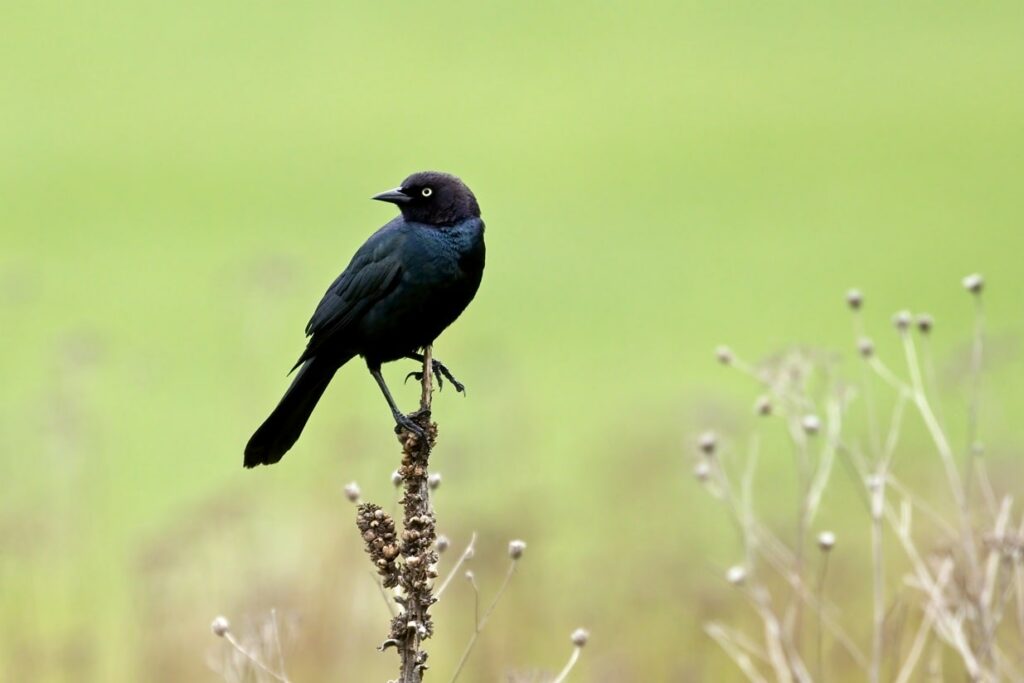
- Scientific Name: Euphagus Cyanocephalus
- Size: 7.9 to 9.8 inches
- Weight: 1.8 to 3 ounces
- Wingspan: 14.6 inches
Brewer’s blackbird is mostly seen in the southern and western parts of the United States as well as the northern portion of Mexico but breeds throughout the central United States and southern Canada.
You can see brewer’s blackbird along quiet places like meadows and stream banks and also around busy places like golf courses and parks.
Not picky in nest building, Brewer’s blackbirds build nests anywhere from twenty to forty feet up in trees to nests in long grass and crevices in cliffs. The female typically has one or two broods per year with each having three to seven eggs.
These blackbirds breed in colonies of up to one hundred, and the first female Brewer’s blackbirds to arrive on-site pick nesting spots that best suit them.
5. Brown-Headed Cowbird

- Scientific Name: Molothrus Ater
- Size: 6.3 to 8.7 inches
- Weight: 1.3 to 1.8 ounces
- Wingspan: 12.6 to 14.2 inches
The brown-headed cowbird is native to North America with the highest concentration in the eastern and southern parts of the United States as well as the northeastern side of Mexico.
They breed throughout the United States and southern parts of Canada. Brown-headed cowbirds like fields, pastures, forest edges, and open lawns.
Unlike other birds, brown-headed cowbirds are nest parasites and will lay their eggs in other birds’ nests instead of building their own.
Brown-headed cowbirds also have unusual egg-laying habits. A female can have one per day for several weeks, laying at least forty eggs per season.
The entire breeding season for brown-headed cowbirds is unusual and there is evidence that males and females are not monogamous and will have several mates in one season.
6. Common Grackle
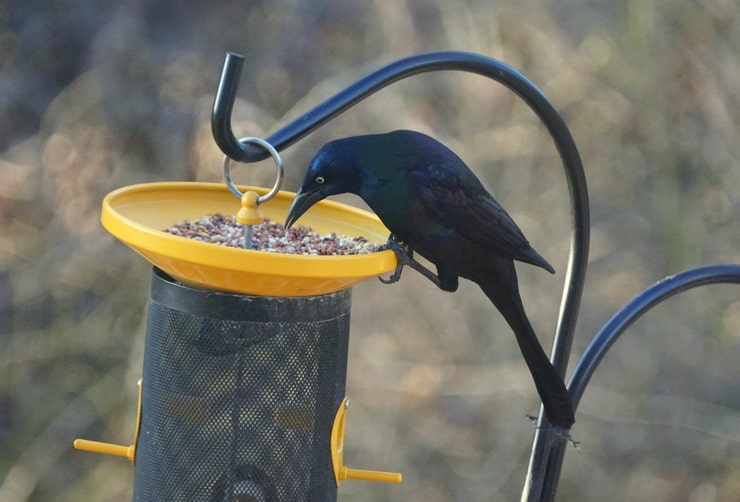
- Scientific Name: Quiscalus Quiscula
- Size: 11 to 13.4 inches
- Weight: 2.6 to 5 ounces
- Wingspan: 14.2 to 18.1 inches
Native to the United States, the common grackle can be seen in the eastern United States but breeds in the central United States and southeastern Canada. Common grackles like open habitats like fields, marshes, feedlots, and forest edges.
Not partial to any nest location, common grackles will build cup-shaped nests in tall grass, tree hollows, holes in logs, and buildings around marshy land. The female will then lay two to six eggs and have one or two broods per year.
Common grackles, not crows, are actually the number one danger to corn in fields as they like to eat both ripening corn and corn sprouts, and their large flocks can do millions of dollars worth of damage.
7. Common Raven
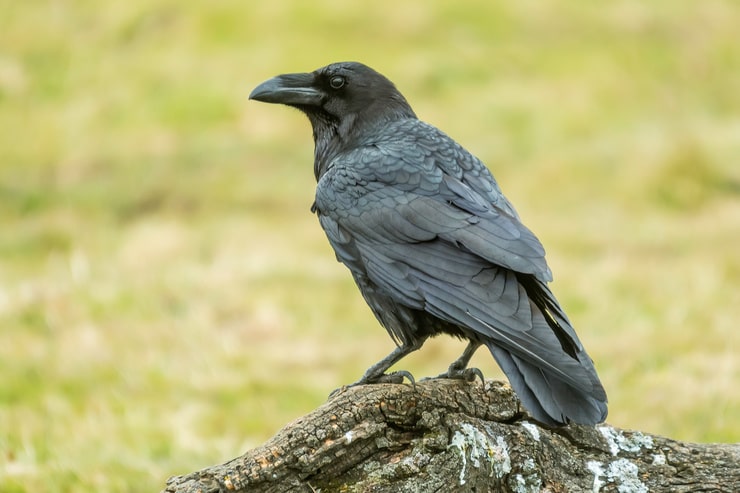
- Scientific Name: Corvus Corax
- Size: 22.1 to 27.2 inches
- Weight: 24.3 to 57.3 ounces
- Wingspan: 45.7 to 46.5 inches
North America is home to the common raven, whose distribution stretches from Canada, down the western side of the United States, and across western and central Mexico.
Being birds that adapt to their environment, common ravens can be seen in as diverse habitats as tundras, deciduous forests, and deserts.
Common ravens build bulky basket nests on the edges of cliffs or up in conifer trees both at relatively high heights. The female will have three to seven eggs in her annual brood.
With smarts on their sides, common ravens make dangerous predators that have been known to distract larger sea birds to get them off their nests while another will steal their egg or chick.
8. European Starling
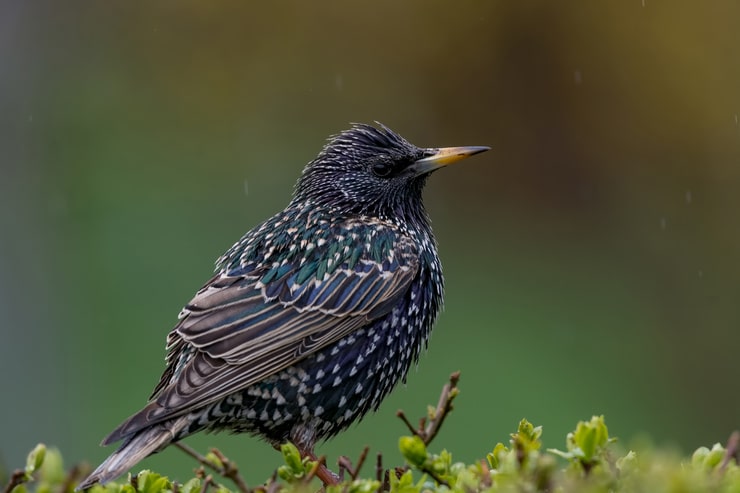
- Scientific Name: Sturnus Vulgaris
- Size: 7.9 to 9.1 inches
- Weight: 2.1 to 3.4 ounces
- Wingspan: 12.2 to 15.8 inches
Despite their names, European starlings can be seen throughout the majority of North America, only excluding the southern tip of Mexico and the northern portion of Canada and Alaska.
Drawn to places with people, European starlings like to make their homes in suburbs, towns, and the countryside where people reside.
Being placed in a cavity is the only thing that European starling nests have in common. Holes in trees, cacti, houses, or other buildings, European starlings have made nests there. Females have two broods per year, each consisting of four to six eggs.
All starlings are talented vocal mimics and can learn call from up to twenty different species.
9. Groove-Billed Ani

- Scientific Name: Sturnus Vulgaris
- Size: 13 inches
- Weight: 2.5 to 3.2 ounces
- Wingspan: 16 to 18 inches
The groove-billed ani is mostly native to Mexico with a little bit of the population extending into the northern portion and west coast of South America. Primarily native to arid climates, you may see a groove-billed ani in wetlands if there is a drought.
Both sexes of a mated couple of groove-billed anis will build a bowl-shaped nest five to fifteen feet up in a shrub or small tree. The female will sometimes have two broods per year and will have three to four eggs in each brood.
The long tail that a groove-billed ani has often whips and thrashes around, which is suspected to help flush out insect prey.
10. Phainopepla
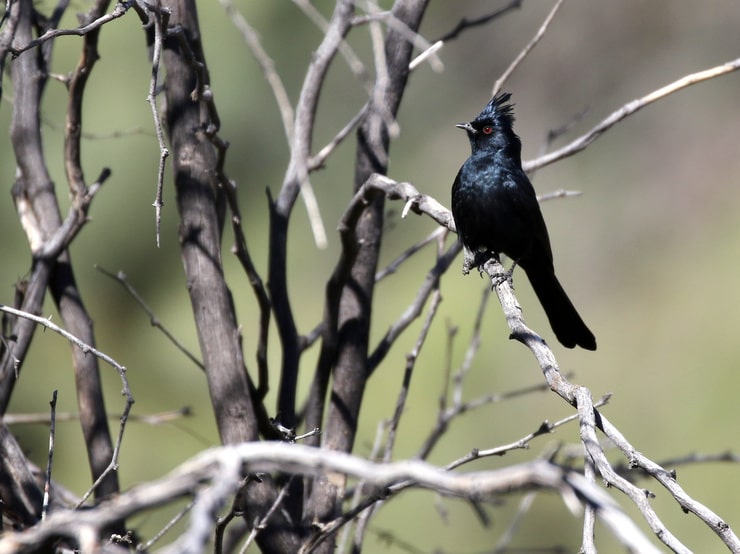
- Scientific Name: Phainopepla Nitens
- Size: 7.1 to 8.3 inches
- Weight: 0.6 to 1 ounce
- Wingspan: 10.6 to 11.4 inches
Mostly native to central Mexico, phainopepla can be spotted in northern Mexico and the most southwest part of the United States during their breeding season.
As their location would suggest, phainopeplas prefer desert habitats that have trees where they can nest.
A male phainopepla takes over the responsibility of building the cup-shaped nest and often places it in mistletoe brambles to obscure it from view. Unlike most birds, phainopeplas breed twice per year in different habitats and have two to three eggs per brood.
Other Colored Birds:
Purple Birds
Blue Birds
White Birds
Pink Birds

What about the beautiful red-winged blackbird? We see them all over the marshy land here in idaho.